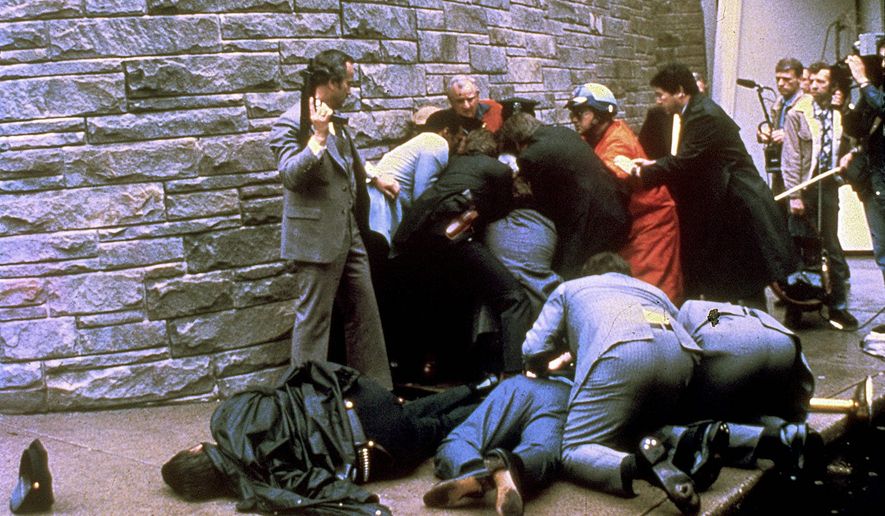OPINION:
So far, Secret Service corner-cutting and laxness have not led to an attack on President Obama. But on March 30, 1981, the Secret Service’s actions led directly to the assassination attempt on President Reagan.
Ironically, Reagan’s own White House staff was most at fault. The Secret Service wanted Reagan to emerge from a speech at the Washington Hilton without any spectators present. The Reagan White House staff overruled the Secret Service, though, insisting for public-relations purposes that crowds have access to the president. The Secret Service improperly backed down and let unscreened bystanders within 15 feet of Reagan. As a result, John W. Hinckley Jr. had a clear shot and almost killed the president.
After the shooting, the Secret Service covered up what had happened. However, as reported in my book “The First Family Detail,” six years after Hinckley shot Reagan the Secret Service’s Office of Training assigned agent William Albracht to teach new agents about what was called the “Reagan Attempt.”
In preparing for the sensitive assignment, Mr. Albracht read all the Secret Service interviews of the agents involved in the incident, studied Hinckley’s history, examined the shooting site, watched video and reviewed photos taken that day, and interviewed the agents who were with Reagan and did the advance.
Even though his findings would have been the lead story in newspapers throughout the country if they had become public, Secret Service management under Director John R. Simpson approved them and certified Mr. Albracht to teach the course at the Rowley Training Center.
On the one hand, Mr. Albracht taught that agents on his detail performed magnificently to save Reagan’s life. But Mr. Albracht’s class synopsis sets forth the damning facts. It says the Reagan White House staff overruled the Secret Service and demanded that the public be allowed without any magnetometer screening almost within touching distance of the president as he left the hotel.
“John Hinckley, a mentally deranged individual, pre-positioned himself in a general public area that the White House staff had requested,” the course synopsis says flatly. “To the White House staff, this was an issue of letting the people see their president. They did not feel that the potential risk factor outweighed the positive PR.” As a result, “the general public area where Hinckley stood 15 feet, seven inches from the leader of the free world was open to all.”
Both the Secret Service’s Washington field office advance agent and the Presidential Protection Division advance agent objected to letting the public into the area, Mr. Albracht states.
“They looked on it as an unneeded security risk,” the synopsis says. “They wanted zero press or public in the area that would be considered within handgun range.”
H. Stuart Knight, who was Secret Service director when the shooting occurred, never revealed what really happened. Indeed, Knight and other Secret Service officials who testified before Congress claimed that looking back, they saw no reason to change the Secret Service’s protective procedures.
Similarly, an August 1981 report on the incident by the Treasury Department, which then included the Secret Service before it was moved to the Department of Homeland Security, concealed the real story. Prepared by Treasury’s general counsel, Peter J. Wallison, it referred vaguely to a need for the Secret Service to work more closely with the White House in setting up protection procedures.
But in commenting for my book, Mr. Wallison, who later served as Reagan’s White House counsel during the president’s second term, confirmed that he learned from his interviews with Secret Service agents who were involved that the Secret Service wanted Reagan to be in a secure environment as he left the Washington Hilton, but the Reagan White House staff overruled them.
“The staff had wanted the president to be seen by the media and the public as he came out from the speech,” Mr. Wallison told me, while the Secret Service “fought that.” He added, “My view now would be that as soon as there is a problem, and the president was shot at and hit, the people in the White House were wrong.”
While the president can overrule the Secret Service, his staff has no authority to do so. Thus, the Secret Service’s spinelessness and recklessness in acceding to the wishes of the Reagan White House led directly to Reagan almost losing his life.
After the shooting, the Secret Service tightened up its procedures. Today, however, that same spinelessness and corner-cutting by the Secret Service has become far worse and more prevalent, well beyond the recent headlines. That includes letting people into events without magnetometer or metal-detection screening, under pressure from White House or campaign staffs. Only a new director from outside the agency can implement reforms necessary to protect the president and his family.
Ronald Kessler, a former Washington Post and Wall Street Journal investigative reporter, is the author of “The First Family Detail: Secret Service Agents Reveal the Hidden Lives of the President” (Crown Forum, 2014).




Please read our comment policy before commenting.